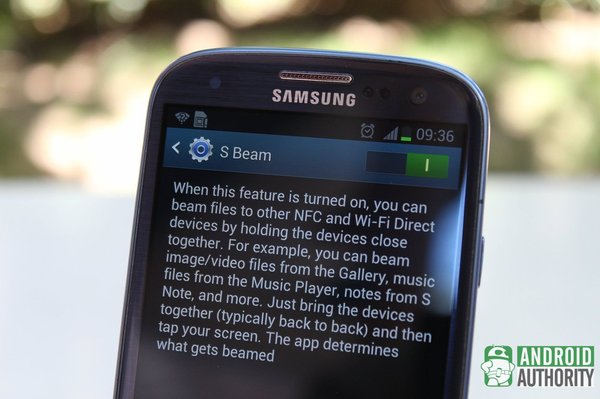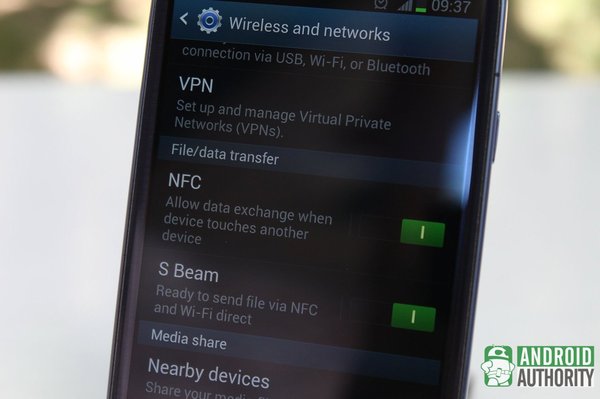Affiliate links on Android Authority may earn us a commission. Learn more.
How to use S Beam
Note: This article was orginally drafted in 2014. Modern Samsung phones no longer utilize S Beam, making the technology antiquated. Still, if you have an older Samsung phone you might find this information useful, so we’ll keep it on our site for posterity.
If you own an older Samsung Android device, it’s possible it might still use S Beam as its means of NFC transfers. If you are rocking an older device, this Samsung S Beam guide is for you. For those with a Sammy handset (or any Android handset really…) that is newer than say the Samsung Galaxy Note 3, S Beam is pretty much extinct and you’ll instead want to check out our Android Beam guide.
Enabling S Beam

Before you can beam files through S Beam, you must first activate S Beam on your Samsung device:
- Go to the Settings page.
- Under Wireless & Networks, tap on More Settings.
- Tap on S Beam to turn it on. NFC will also be automatically enabled. If NFC is not active, S Beam won’t work.
S Beaming content

To successfully share files and content through S Beam, take note of the following:
- Both the sender and receiver devices must have the S Beam feature and it must be active. NFC must also be active on both devices.
- Neither of the devices should be asleep or locked. The receiver device must preferably be on the Home screen.
- The phones will make a sound and vibrate slightly when they detect each other.
- Only separate your devices when you are prompted to. Separating them before beaming may prevent the transfer from starting.
- S Beam only sends locally saved files. Files saved in your Picasa account, for example, cannot be beamed.
S Beam essentially works just like Android Beam. The general steps for sending content from a device to the other is as follows:
- Open the file/content to be shared on the sender device.
- Place the backs of both devices against each other. The devices will beep and vibrate slightly (if supported) to confirm that they are within beaming range.
- On the sender device, you’ll see “Touch to beam” on the screen.
- Tap on the sender device’s screen to start sending the content.
- When prompted to do so, separate the devices to begin beaming.
- Upon completion, the content will be opened by the appropriate handler app on the receiver device.
But what about other types of content? It depends, but here’s the quick run-down:
- Beaming photos or images: To beam images, just follow the standard way for S Beaming content. Open a photo or image from the Gallery and beam away. The receiver device’s Gallery app will show the image after transfer is completed.
- Beaming music: Beaming music tracks follows the same standard procedure for S Beam. Just play the music track in the sender device’s Music Player app and beam away. When beaming completes, the receiver device automatically plays the received track.
- Beaming videos: To beam local videos, just play the video on the sender device’s Video Player app and beam away. The receiver device automatically opens and plays the received video after beaming completes.
- Beaming contacts: You don’t need to manually copy contact information from one device to another anymore. With S Beam, you can easily share contacts. Just open the contact’s info page on the sender device, then beam away in the usual way. When beaming completes, the receiver device will ask where to save the beamed contact to.
- Beaming apps: Just like with Android Beam, you can also share Android apps via S Beam. This procedure doesn’t send the app’s files to the other device, though. Instead, it will send the app’s Google Play Store URL to the other device. To share an app, just launch the app to be beamed, then beam it in the usual way. The receiver device opens the app’s page on the Google Play Store. An Internet connection is needed to access the Google Play Store.
- Beaming webpages: When you S Beam a webpage, the sender device doesn’t beam the page itself. Instead, only the URL is sent and the receiver device opens it in its native browser app. To beam a webpage, just open the page in the sender device’s browser app, and beam away as usual. An Internet connection is needed to open webpages, of course.
- Beaming YouTube videos: Want to share the YouTube video that you’re watching? Go ahead. Just open the YouTube video page on the sender device, beam in the usual way, and the receiver device automatically opens it in the YouTube app upon beam completion. Both devices need to be connected to the Internet, of course; otherwise, YouTube won’t open.
- Beaming other content: You can also beam many other types of mobile content, such as Google Maps data and Google Search results, between supported Samsung devices.
While the NFC and Android Beam combo makes data sharing over Bluetooth easier and less cumbersome, the NFC and Wi-Fi Direct tandem in the form of Samsung’s S Beam makes data transfers of larger files quicker. It is a heaven-sent feature among Samsung fans who frequently swap files and content using their Android devices.